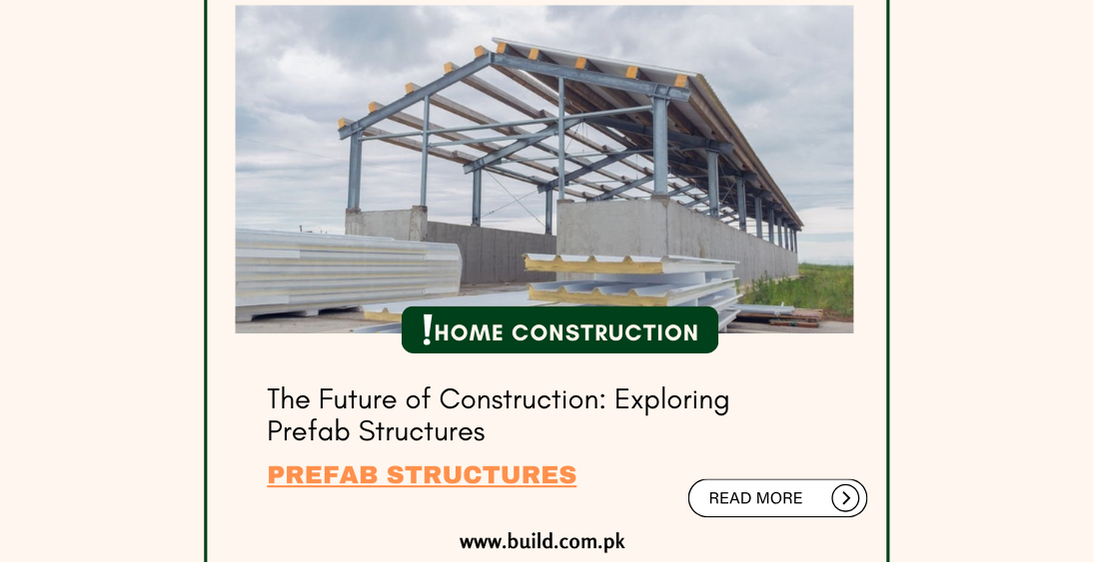The Future of Construction: Exploring Prefab Structures

Introduction:
Innovations in construction technology have
revolutionized the way we build, with prefab structures emerging as a
cutting-edge solution for efficient, sustainable, and cost-effective building
projects. Prefabricated construction, or prefab for short, involves assembling
building components off-site in a controlled environment before transporting
them to the construction site for final assembly. In this comprehensive blog,
we'll delve into the world of prefab structures, exploring their benefits,
applications, and thefuture of construction in the prefab era.
Understanding Prefab Structures:
Prefab structures, also
known as prefabricated buildings or modular buildings, are constructed using
pre-made components that are manufactured off-site and then transported to the
construction site for assembly. These components can include walls, floors,
roofs, and even entire rooms or modules. Prefab structures can be made from a
variety of materials, including steel, wood, concrete, and composites,
depending on the specific requirements of the project.
Key Features and Benefits
Speed of Construction:
Prefab structures are constructed much
faster than traditional buildings, as the majority of the work is done off-site
in a controlled environment. This reduces construction time and minimizes
disruptions to the surrounding area.
Cost-Effectiveness:
Prefab construction can be more
cost-effective than traditional construction methods, as it reduces labor
costs, material waste, and construction delays. Additionally, prefab components
are often manufactured in bulk, leading to economies of scale and lower overall
project costs.
Quality Control:
Prefab structures are built in a controlled
factory setting, where quality control measures can be strictly enforced. This
results in higher-quality construction and fewer defects compared to on-site
construction methods.
Sustainability:
Prefab structures are inherently more
sustainable than traditional buildings, as they produce less waste, use fewer
resources, and can be designed to be energy-efficient. Additionally, many
prefab components are made from recycled or environmentally-friendly materials,
further reducing their environmental impact.
Versatility:
Prefab construction is highly versatile and can
be used for a wide range of building types, including residential homes,
commercial buildings, schools, hospitals, and even temporary structures such as
disaster relief shelters or event venues.
Applications of Prefab Structures
Prefab structures have
numerous applications across various industries, including:
Residential Construction:
Prefab homes are becoming
increasingly popular due to their affordability, speed of construction, and
customizable design options. Prefab homes can range from simple, single-family
dwellings to luxurious custom-built residences.
Commercial Buildings:
Prefab structures are widely used for
commercial buildings such as offices, retail stores, restaurants, and
warehouses. These buildings can be quickly assembled to meet the needs of
businesses and organizations, allowing for rapid expansion or relocation.
Educational Facilities:
Prefab structures are ideal for
educational facilities such as schools, colleges, and universities, where fast
construction timelines and flexible design options are essential.
Healthcare Facilities:
Prefab structures can be used to build
healthcare facilities such as hospitals, clinics, and medical offices,
providing durable, cost-effective solutions for healthcare providers.
Industrial Applications:
Prefab structures are also used in
industrial settings for purposes such as manufacturing facilities, storage
warehouses, and distribution centers, where speed, efficiency, and durability
are paramount.
Future Trends in Prefab Construction
The future of prefab
construction looks promising, with several trends shaping the industry:
Technological Advancements:
Advances in technology, including
Building Information Modeling (BIM), 3D printing, and robotic automation, are
revolutionizing the prefab construction process, making it faster, more
efficient, and more precise.
Sustainable Design:
With a growing focus on sustainability
and environmental responsibility, prefab construction is embracing green
building practices such as passive design, renewable energy integration, and
eco-friendly materials.
Modularization:
Modular construction, where entire building
modules are fabricated off-site and assembled on-site, is gaining popularity
for its efficiency and scalability. This approach allows for greater
customization and flexibility in building design.
Smart Buildings:
Prefab structures are increasingly
incorporating smart building technologies such as IoT (Internet of Things)
sensors, energy management systems, and automation controls, enhancing comfort,
efficiency, and security.
Customization and Personalization:
Prefab construction is
moving away from one-size-fits-all solutions towards customizable and
personalized designs, allowing clients to tailor their buildings to meet their
specific needs and preferences.
Conclusion:
Prefab structures represent the future of construction, offering a faster, more efficient, and more sustainable alternative to traditional building methods. With their numerous benefits, including speed of construction, cost-effectiveness, quality control, and versatility, prefab structures are becoming increasingly popular across various industries. As technology continues to evolve and innovation drives the industry forward, prefab construction is poised to revolutionize the way we build, creating smarter, greener, and more resilient communities for generations to come.









